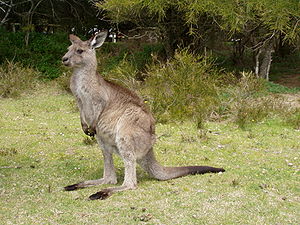Diprotodontia
| Diprotodontia | ||||||||||||
|---|---|---|---|---|---|---|---|---|---|---|---|---|

Eastern gray giant kangaroo ( Macropus giganteus ) |
||||||||||||
| Systematics | ||||||||||||
|
||||||||||||
| Scientific name | ||||||||||||
| Diprotodontia | ||||||||||||
| Owen , 1866 |
The Diprotodontia , for which there is currently no German name, are an order from the subclass of marsupials . With approximately 140 species , they are the most species-rich order of this subclass. They include well-known marsupials such as kangaroos , koalas and wombats .
distribution
Diprotodontia are found in Australia and offshore islands, on New Guinea , in eastern Indonesia (from Sulawesi to the east) and on the Solomon Islands .
description
The commonalities of the Diprotodontia lie in the teeth and in the structure of the foot bones. The name translates as "two first teeth", which indicates that a large pair of incisors dominates the lower jaw. Another, smaller pair may be present. In the upper jaw there are usually six incisors (except for the wombats). Another feature is that the second and third toes of the rear limbs have grown together.
Species with a sliding membrane have developed in three families, the glide pouches , the ring pouches and the dwarf glide pouches .
food
Most species of Diprotodontia are herbivores. Some species specialize in insects or, like the proboscis, in nectar.
Reproduction
Diprotodontia are marsupials, which means that after a short gestation period, relatively underdeveloped young animals are born and grow up protected in the mother's pouch. Most diprotodontia have well-developed pouches. A special feature that occurs in some families (for example the kangaroos) is delayed birth: Immediately before or after birth the female mates again, but the new embryo only grows to a size of around 100 cells, then he stops growing. Only when the old cub leaves the pouch (or dies) does it continue to grow. This way, there is less time between births and the female can look after three young at the same time: one in the uterus, one in the pouch and one outside the pouch.
The families of this order
The order is divided into eleven recent families:
- Koalas (Phascolarctidae)
- Wombats (Vombatidae)
- Musk rat kangaroos (Hypsiprymnodontidae)
- Rat kangaroos (Potoroidae)
- Kangaroos (Macropodidae)
- Bilchbeutler (Burramyidae)
- Glide pouches (Petauridae)
- Ringbeutler (Pseudocheiridae)
- Dwarf gliding pouch (Acrobatidae)
- Climbing Burs (Phalangeridae)
- Proboscis (Tarsipedidae)
The extinct families of the Diprotodontia include:
- Diprotodontidae , which included Diprotodon , the largest marsupial that ever lived. Other representatives of the family were Zygomaturus and Hulitherium , which belonged to the subfamily of the Zygomaturinae. Like Diprotodon , both survived into the late Pleistocene.
- Palorchestidae , whose typical representative was the peculiar bag tapir ( Palorchestes ).
- Marsupial lions (Thylacoleonidae), which developed from the herbivorous Diprotodontia again into carnivores and whose best-known representative was Thylacoleo carnifex .
Systematics
| Diprotodontia |
|
||||||||||||||||||||||||||||||||||||||||||||||||||||||||||||
|
|
literature
- Ronald M. Nowak: Walker's Mammals of the World. Johns Hopkins University Press, Baltimore 1999, ISBN 0-8018-5789-9 .
- DE Wilson, DM Reeder: Mammal Species of the World. Johns Hopkins University Press, Baltimore 2005, ISBN 0-8018-8221-4 .
Individual evidence
- ↑ Laura J. May-Collado, C. William Kilpatrick, Ingi Agnarsson: Mammals from 'down under': a multi-gene species-level phylogeny of marsupial mammals (Mammalia, Metatheria) . PeerJ . 2015 Feb 26; 3: e805. doi: 10.7717 / peerj.805 . eCollection 2015.